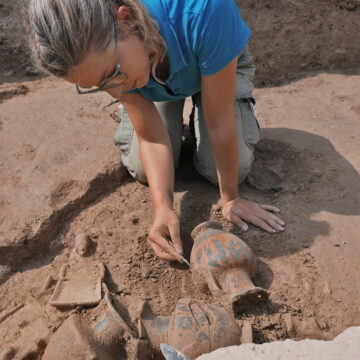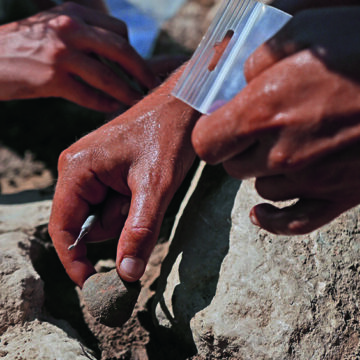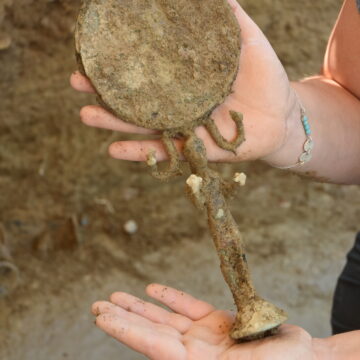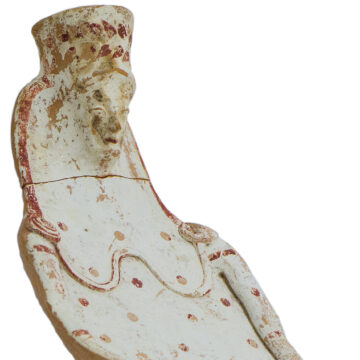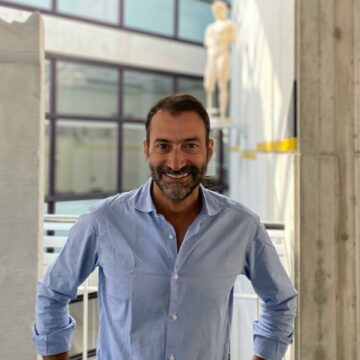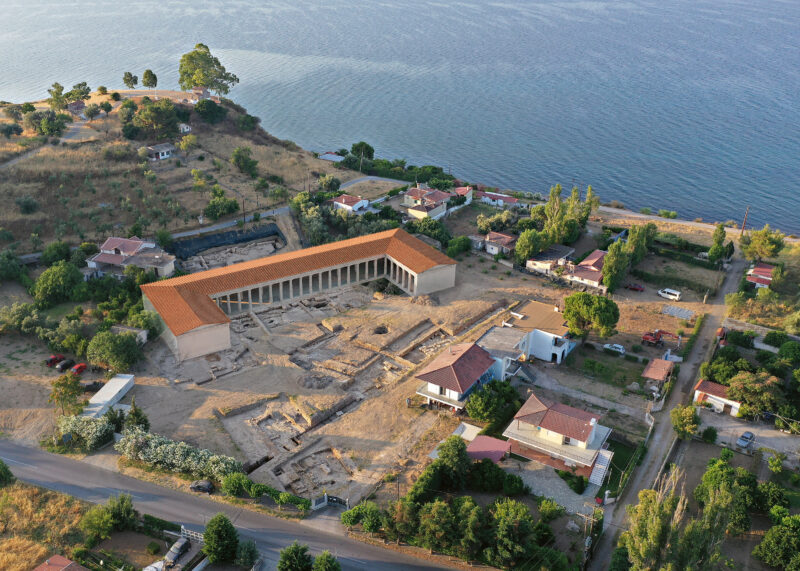ESAG New Director
Appointment of Director and the scent of sensational discoveries
Sylvian Fachard, Professor of Classical archaeology at the University of Lausanne, will take over as Director of the Swiss School of Archaeology in Greece (ESAG) on July 1st, 2021. This date also marks the opening of an excavation campaign full of promises at the sanctuary of Artemis Amarysia on the island of Euboea.
Professor Sylvian Fachard, an expert on the territory of ancient Eretria –a city located on the island of Euboea in Greece– is taking up his post in an inspiring context. Indeed, there are great prospects for the excavation of the sanctuary of Artemis at Amarynthos, the place name from which the goddess derives the epithet “Amarysia.” A limited 2020 season already brought to light exceptional discoveries in the sector of the Archaic temple: more than 300 objects of exceptional quality and preservation, including black-figure vases, a bronze mirror, more than 20 terracotta figurines, and small objects and jewelry made of bronze, ivory, bone, and faience. The excavation will continue in 2021, setting the stage for great discoveries.
Biography
Appointed full professor at the University of Lausanne (UNIL) in August 2020, Sylvian Fachard has successively occupied the positions of Scientific Secretary of the ESAG while preparing his doctoral thesis, Researcher at the Harvard Center for Hellenic Studies in Washington D.C. and Postdoctoral fellow at Brown University in Providence. Professor Fachard has also been the recipient of an SNSF Ambizione grant at the University of Geneva.Between 2017 and 2020, he was the A.W. Mellon Professor at the American School of Classical Studies at Athens.
In addition to his professorship, he pursues his career path as Director of the Swiss School of Archaeology in Greece, succeeding Professor Karl Reber, who retired in June 2021.
The quest for the lost sanctuary of Artemis
Historical sources associate the name of Amarynthos with an important sanctuary of Artemis located near Eretria on the island of Euboea. The most important public documents, engraved on steles, were displayed there. The festival organised by the Eretrians to celebrate the goddess, the Artemisia, was the most prestigious in Eretria. It attracted citizens not only from the four cities of Euboea, but also from the rest of the Greek world.
The location of the sanctuary remained a puzzle for researchers for over a century. Yet, thanks to the dedication of Denis Knoepfler, former Professor at the University of Neuchâtel and the Collège de France –who had been searching for the location of this mythical site throughout his career–, the Swiss School launched major research campaigns at Amarynthos, a small village 10km from Eretria. The excavation of 2007 was decisive: the massive foundations of a monumental building, covered by more than 2m of sediment, appeared at the bottom of a narrow trench.
Over the next ten years, the Swiss School purchased several plots of land to extend its investigations. The excavations carried out each year in collaboration with the Ephorate of Antiquities of Euboea brought several monuments to light. Among them was a long portico attesting to the existence of a monumental building complex, which could tentatively be identified with the sanctuary of Artemis Amarysia. Written evidence, however, was still missing…
The team’s patience was finally rewarded in 2017, with the discovery of a stamped tile bearing the name of the goddess, as well as statue bases bearing votive inscriptions. These finds cleared the last remaining doubts as to the identification of the remains. The sanctuary of Artemis Amarysia had been officially discovered.
State-of-the-art excavations
The most significant ancient Greek sanctuaries were mainly excavated during the 19th and early-20th centuries. Therefore, the discovery of the sanctuary of Artemis Amarysia constitutes a rare opportunity to excavate a shrine using modern, cutting-edge technology and methodology. It also offers a unique case study for understanding the development of sanctuaries at the dawn of Classical Greece. The research campaigns, financed by the Swiss National Science Foundation (SNSF) and the State Secretariat for Education, Research and Innovation (SERI), allow for the collection of new data which, combined with the knowledge acquired over the last few decades, will offer a rare opportunity for the study of the relationship between the urban center of a Greek polis and an important extra-urban religious pole.
The fieldwork at Amarynthos is co-directed by Prof. Sylvian Fachard (ESAG-UNIL) and Dr. Angeliki Simosi (Ephorate of Antiquities of Euboea).
When Archaeology rimes with Technology
Today’s archaeologists have many techniques when studying ancient remains. In addition to the tradtional tools, such as shovels, trowels and brushes, state-of-the-art technologies are also extensively used in archaeological research. Such methods include: Geophysical Prospection, Remote Sensing, Palynology, Micromorphology, Digital Data Recording, Geographic Information System, Photogrammetry.
The Swiss School of Archaeology in dates
Since 1964, a Swiss Archaeological Mission has been studying the remains of the ancient city of Eretria on the island of Euboea. In 1975 it became the “Swiss School of Archaeology in Greece” (ESAG). It embodies the only permanent Swiss archaeological mission outside Switzerland. Its scientific activities take place mainly on the site of ancient Eretria and its wider territory.
The ESAG provides an educational and scientific platform for the next generation of academics. More than 30 Master’s theses and dissertations have been defended in the last ten years. Furthermore, through the ESAG, students from Swiss Universities have the opportunity to take part in field and museum activities every year.
ESAG homepageContact
Sylvian Fachard
Professor of Classical Archaeology
University of Lausanne
Switzerland
+41 079 342 45 86
sylvian.fachard@unil.ch
